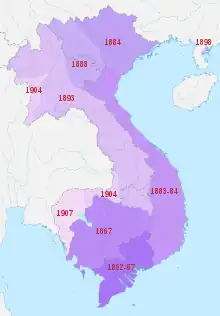
Map showing the territorial evolution of French Indochina; the region in the south marked "1862–67" was ceded in the Treaty of Saigon (1862).
The Treaty of Saigon (French: Traité de Saïgon, Vietnamese: Hòa ước Nhâm Tuất, referring to the year of "Yang Water Dog" in the sexagenary cycle) was signed on 5 June 1862 between representatives of the French Empire and the last precolonial emperor of the House of Nguyen, Emperor Tự Đức. Based on the terms of the accord, Tự Đức ceded Saigon, the island of Poulo Condor and three southern provinces of what was to become known as Cochinchina (Bien Hoa, Gia Dinh, and Dinh Tuong) to the French. The treaty was confirmed by the Treaty of Huế signed on 14 April 1863.[1]
See also
References
- ↑ "Treaty of Saigon 1862, the "first" unequal treaty between France and Vietnam". baotanglichsu.vn. Retrieved 15 May 2023.
- Stearns, Peter N. (ed.). Encyclopedia of World History (6th ed.). The Houghton Mifflin Company/Bartleby.com.
The Second Treaty of Saigon
- The Encyclopedia of the Nations – Country Data – Vietnam
- C'est arrivé un jour – 5 Juin
This article is issued from Wikipedia. The text is licensed under Creative Commons - Attribution - Sharealike. Additional terms may apply for the media files.


_colour_scheme_-_%C4%90%E1%BA%A1i_Nam_(%E5%A4%A7%E5%8D%97).svg.png.webp)